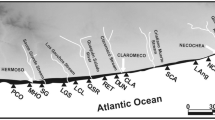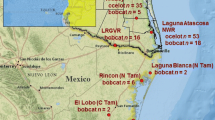Abstract
Context
Species show different sensitivity to habitat loss and fragmentation depending on their specialization. Populations of a species at the range margin are generally assumed to be more stenoecious than populations at the core of the distribution and should therefore be more sensitive to habitat fragmentation.
Objectives
We evaluated the hypothesis that fragmentation effects species more strongly at the range periphery of their range compared to the core, resulting in lower genetic variability in comparable patch sizes and lower gene flow among populations.
Methods
We compared the genetic diversity and structure of five sand lizard (Lacerta agilis) populations at the margin of its range in Bulgaria and of 11 populations at the core of its distribution in Germany. We based the analysis on microsatellites, comprising 15 loci in Bulgaria and 12 in Germany.
Results
All diversity indices declined with patch size. For medium-sized patches all diversity indices were lower at the range periphery compared to the core, with two of them being significant. AICc based model selection showed strong support for core/periphery and patch size effects for observed and expected heterozygosity but only a patch size effect for allelic richness. There was no isolation-by-distance and each sampled population was allocated to a separate cluster with high probability for both countries, indicating that all populations are (almost) completely isolated.
Conclusion
Our study indicates an increased sensitivity of a species to fragmentation at the periphery compared to the core of its distribution. This differential sensitivity should be accounted for when prioritizing species based on their fragmentation sensitivity in landscape management.





Similar content being viewed by others
References
Andres C, Franke F, Bleidorn C, Bernhard D, Schlegel M (2014) Phylogenetic analysis of the Lacerta agilis subspecies complex. Syst Biodivers 12:43–54
Arenas M, Ray N, Currat M, Excoffier L (2012) Consequences of range contractions and range shifts on molecular diversity. Mol Biol Evol 29:207–218
Böhme W, Rödder D (2008) Amphibien und Reptilien: Verbreitungs- und Verhaltensänderungen aufgrund der Erderwärmung. In: Lozán JL, Graß H, Jendritzky G, Karbe L, Reise K (eds) Warnsignal Klima: Erderwärmung. Wissenschaftliche Auswertungen. GEO, Hamburg, pp 103–107
Burnham KP, Anderson AR (2002) Model selection and multimodel inference. A practical information–theoretic approach. Springer, New York
Delaney KS, Riley SPD, Fisher RN (2010) A rapid, strong, and convergent genetic response to urban habitat fragmentation in four divergent and widespread vertebrates. PLoS One 5(9):e12767
Devictor V, Julliard R, Jiguet F (2008) Distribution of specialist and generalist species along spatial gradients of habitat disturbance and fragmentation. Oikos 117:507–514
Dudaniec RY, Spear SF, Richardson JS, Storfer A (2012) Current and historical drivers of landscape genetic structure differ in core and peripheral salamander populations. PLoS One 7:e36769
Eckert CG, Samis KE, Lougheed SC (2008) Genetic variation across species’ geographical ranges: the central-marginal hypothesis and beyond. Mol Ecol 17:1170–1188
Elbing K, Günther R, Rahmel U (1996) Zauneidechse—Lacerta agilis Linnaeus, 1758. In: Günther R (ed) Die Amphibien und Reptilien Deutschlands. Fischer, Jena, pp 535–557
ESRI (2011) ArcGIS Desktop: Release 10. Environmental Systems Research Institute, Redlands
Excoffier L, Lischer HEL (2010) Arlequin suite ver 3.5: a new series of programs to perform population genetics analyses under Linux and Windows. Mol Ecol Resour 10:564–567
Fontaine MC, Baird SJE, Piry S, Ray N, Tolley KA, Duke S, Birkun A, Ferreira M, Jauniaux T, Llavona A, Öztürk B, Öztürk AA, Ridoux V, Rogan E, Sequeira M, Siebert U, Vikingsson GA, Bouquegneau J-M, Johan R, Michaux JR (2007) Rise of oceanographic barriers in continuous populations of a cetacean: the genetic structure of harbour porpoises in Old World waters. BMC Biol 5(30). doi:10.1186/1741-7007-5-30
Frankham R (2005) Genetics and extinction. Biol Conserv 126:131–140
Gerlach G, Jueterbock A, Kraemer P, Deppermann J, Harmand P (2010) Calculations of population differentiation based on GST and D: forget GST but not all of statistics! Mol Ecol 19:3845–3852
Goslee S, Urban D (2012) ecodist: Dissimilarity-based functions for ecological analysis. Version 1.2.7. Available from http://cran.r-project.org/web/packages/ecodist/index.html. Accessed November 2013
Grimm A, Prieto Ramirez AM, Moulherat S, Reynaud J, Henle K (2014) Life-history trait database of European reptile species. Nat Conserv 9:45–67
Grosse W-R (2009) Verbreitung der Kriechtiere (Reptilia) in der Stadt Leipzig (Sachsen). Jahresschr Feldherpetol Ichthyofaun Sachsen 11:47–75
Guillot G (2008) Inference of structure in subdivided populations at low levels of genetic differentiation—the correlated allele frequencies model revisited. Bioinformatics 24:2222–2228
Guillot G, Mortier F, Estoup A (2005) Geneland: a computer package for landscape genetics. Mol Ecol Notes 5:712–715
Gullberg A, Tegelström H, Olsson M (1997) Microsatellites in the sand lizard (Lacerta agilis): description, variation, inheritance, and applicability. Biochem Genet 35:281–295
Haase D, Nuissl H (2010) The urban-to-rural gradient of land use change and impervious cover: a long-term trajectory for the city of Leipzig. J Land Use Sci 5:123–141
Heller R, Siegismund HR (2009) Relationship between three measures of genetic differentiation GST, DEST and G’ST: how wrong have we been? Mol Ecol 18(10): 2080-2083
Henle K, Davies KF, Kleyer M, Margules CR, Settele J (2004) Predictors of species sensitivity to fragmentation. Biodivers Conserv 13:207–251
Hirt S (2008) Landscapes of postmodernity: changes in the built fabric of Belgrade and Sofia since the end of socialism. Urban Geogr 29:785–810
Hoehn M, Sarre S, Henle K (2007) The tales of two geckos: does dispersal prevent extinction in recently fragmented populations? Mol Ecol 16:3299–3312
Jellinek S, Driscoll DA, Kirkpatrick JB (2004) Environmental and vegetation variables have a greater influence than habitat fragmentation in structuring lizard communities in remnant urban bushland. Aust Ecol 29:294–304
Jost L (2008) GST and its relatives do not measure differentiation. Mol Ecol 17:4015–4026
Kalinowski ST (2005) Hp-Rare 1.0: a computer program for performing rarefaction on measures of allelic richness. Mol Ecol Notes 5:187–189
Kalyabina SA, Milto KD, Ananjeva NB, Legal L, Joger U, Wink M (2001) Phylogeography and systematics of Lacerta agilis based on mitochondrial cytochrome B gene sequences: first results. Russ J Herpetol 8:149–158
Märtens B (1999) Demographisch ökologische Untersuchung zu Habitatqualität, Isolation und Flächenanspruch der Zauneidechse (Lacerta agilis, Linnaeus, 1758) in der Porphyrkuppenlandschaft bei Halle (Saale) Bremen. PhD University of Bremen, Bremen
Mazerolle MJ (2013) AICcmodavg: model selection and multimodal inference based on (Q)AIC(c). Version 1.33. http://cran.r-project.org/web/packages/AICcmodavg/index.html. Accessed 11 Nov 2013
Miller JR, Hobbs RJ (2002) Conservation where people live and work. Conserv Biol 16:330–337
Mona S, Ray N, Arenas M, Excoffier L (2014) Genetic consequences of habitat fragmentation during a range expansion. Heredity 112:291–299
Munwes I, Geffen E, Roll U, Friedmann A, Daya A, Tikochinski Y, Gafny S (2010) The change in genetic diversity down the core-edge gradient in the eastern spadefoot toad (Pelobates syriacus). Mol Ecol 19:2675–2689
Nei M (1973) Analysis of gene diversity in subdivided populations. PNAS 70:3321–3323
Öckinger E, Schweiger O, Crist TO, Debinski DM, Krauss J, Kuussaari M, Petersen JD, Pöyry J, Settele J, Summerville KS, Bommarco R (2010) Life-history traits predict species responses to habitat area and isolation: a cross-continental synthesis. Ecol Lett. 13:969–979
Palumbi SR (2003) Population genetics, demographic connectivity, and the design of marine reserves. Ecol Appl 13:S146–S158
Pike N (2011) Using false discovery rates for multiple comparisons in ecology and evolution. Methods Ecol Evol 2:278–282
R Core Team (2015) A language and environment for statistical computing. Version 3.1.1. Available at: http://www.r-project.org/
Raymond M, Rousset F (1995) GENEPOP (Version 1.2): Population genetics software for exact tests and ecumenicism. J Hered 86:9–10
Rousset F (1997) Genetic differentiation and estimation of gene flow from F-statistics under isolation by distance. Genetics 145:1219–1228
Schwartz TS, Olsson M (2008) Microsatellite markers developed for a Swedish population of sand lizard (Lacerta agilis). Conserv Genet 9:715–717
Sillero N, Campos J, Bonardi A, Corti C, Creemers R, Crochet P-A, Crnobrnja Isailovic J, Denoël M, Ficetola GF, Gonçalves J, Kuzmin S, Lymberakis P, de Pous P, Rodríguez A, Sindaco R, Speybroeck J, Toxopeus B, Vieites DR, Vences M (2014) Updated distribution and biogeography of amphibians and reptiles of Europe. Amphib Reptil 35:1–31
Soulé ME (1986) Viable populations for conservation. Cambridge University Press, Cambridge
Stoyanov A, Tzankov N, Naumov B (2011) Die Amphibien und Reptilien Bulgariens. Chimaira, Frankfurt am Main
Tukey JW (1959) A quick, compact two-sample test to Duckworth’s specifications. Technometrics 1:31–48
Tzankov N, Popgeorgiev G, Kornilev Y, Petrov B, Zidarova S, Stefanov T (2015) Sofia. In: Kelcey J (ed) Vertebrates and invertebrates of European cities: selected non-avian fauna. Springer, New York, pp 179–206
Van Oosterhout C, Hutchinson WF, Wills DPM, Shipley P (2004) Micro-Checker: software for identifying and correcting genotyping errors in microsatellite data. Mol Ecol Notes 4:535–538
Wright S (1951) The genetical structure of populations. Ann Eugenics 15:323–354
Wright S (1978) Evolution and the genetics of populations. Genetics 16:97–159
Young AG, Clarke GM (2000) Genetics, demography and viability of fragmented populations. University of Chicago Press, Chicago
Acknowledgments
We thank Conrad Helm, Stefan Schaffer, Ana María Prieto Ramírez, Ronny Wolf and Nico Hesselbarth for assisting in the field and Heiko Stukkas for assistance concerning some of the statistical analyses.
Author information
Authors and Affiliations
Corresponding author
Additional information
Nikolay Tzankov recently deceased
Electronic supplementary material
Below is the link to the electronic supplementary material.
Rights and permissions
About this article
Cite this article
Henle, K., Andres, C., Bernhard, D. et al. Are species genetically more sensitive to habitat fragmentation on the periphery of their range compared to the core? A case study on the sand lizard (Lacerta agilis). Landscape Ecol 32, 131–145 (2017). https://doi.org/10.1007/s10980-016-0418-2
Received:
Accepted:
Published:
Issue Date:
DOI: https://doi.org/10.1007/s10980-016-0418-2




